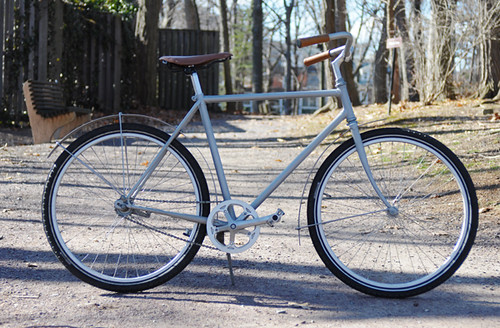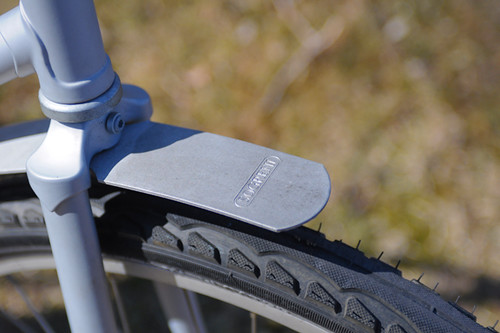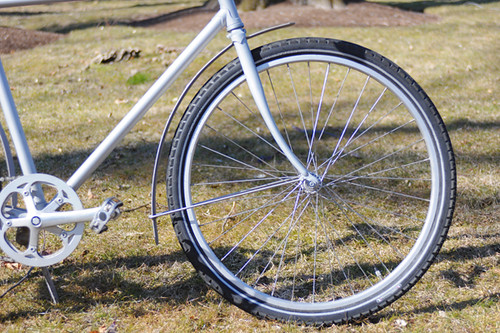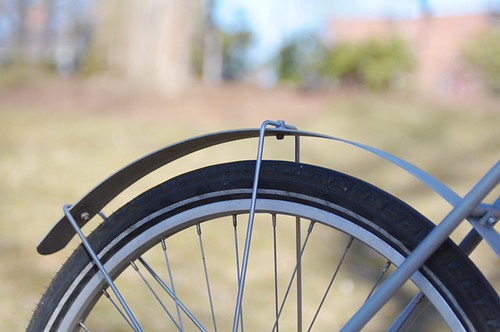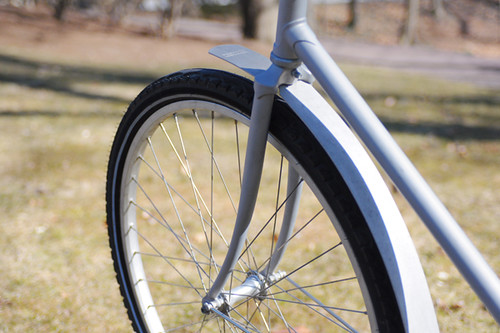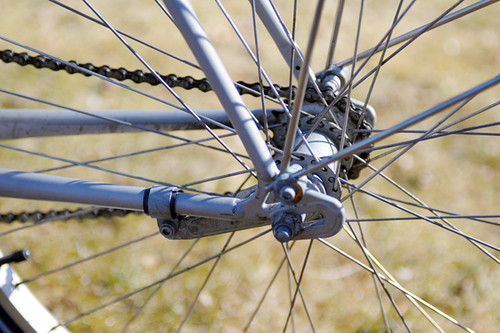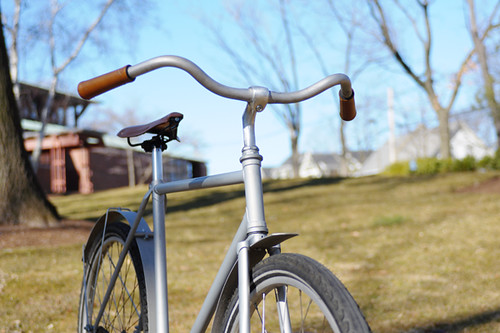According to his obituary, published in the Columbia City Commercial on December 14, 1904 Henry Robison (Jr) was the son of Henry and Ann Robison and was born in Champaign County, Ohio on January 7, 1833. "He came to Indiana at an early age and at the beginning of the civil war enlisted in Co L of the 80th Indiana regiment of volunteers for three years, and at the expiration thereof reenlisted and served until the close of the war when he was honorably discharged. During his faithful service he was hit by a piece of shell on the left shoulder causing his left arm to be helpless, but remained with his Company until the close of the war cheering by words and songs." For a number of years Henry and Lucy were the proprietors of the "Robinson House" in Lorane.
Whitley County records show that Henry enlisted in Company I of the 30th Indiana Regiment Indiana Volunteer Infantry (not Co. L 80th IVI). He was wounded on April 7, 1862 at Pittsburgh Landing.
On October 10, 1867 Henry Robison Jr. was married to Lucy Ann (Strait) Scott. Lucy had three children from her previous marriage to Charles Scott but only two were living at the time of her death in January 1907; they were Perry Scott of Marion, Indiana and Mrs. Harvey Waters of Lorane. Henry and Lucy had four children: Ella, Frank, Ida Anna, and Pearl Henry.

You can read this post to find out how the photograph above gives me my "link" to Henry and Ann Robison!
1. Ella was born about 1868 and married C. M. Kimball on February 13, 1897 in Whitley County. In the obituary notice of her father she is mentioned as Mrs. Ella Kimbal Mt. Carmel, Illinois. Her mother's obituary gives her name as Mrs. Ella Kimmel. Additional information on them can be found at Ella/Ellen Robison and C. M. Kimball. [Link added 09/18/..]
2. Frank Robison was born about 1869. He married Cora B. Beard on August 23, 1891 in Whitley County, Indiana. The obituary notices of his parents stated that Frank lived in Marion, Indiana (Grant County) and that is where he was found in the census records for 1900 through 1930. Additional information on them can be found at Frank and Cora Robison of Marion, Indiana. [Link added 09/18/..]
3. Ida Anna Robison was born January 17, 1872 and died November 22, 1899 in Whitley County, Indiana.
 Her obituary was found in my grandmother's papers. The clipping is not identified (no name of newspaper or date of publication). "On Friday of last week this community was called upon to pay their last tribute of respect to one that has been with us from infancy, attended our school and our social gatherings, and our pen cannot describe the sad parting. Ida A. Robison was born in Troy township, Whitley county, Indiana on January 17, 1872 and died November 22, 1899, aged 27 years, 10 months and 3 days. Anna was a patient sufferer for nearly four years of the dread disease consumption which has claimed her as its victim. Her last days were her happiest, fully realizing that the end was near she never complained but was pleased with what little could be done for her to relieve her sufferings and was submissive to the Lord's will in whose care she had placed her trust. Rejoicing in the hope of meeting kind parents, brothers and sisters in heaven she shook hands with all present and peacefully passed to the spirit world."
Her obituary was found in my grandmother's papers. The clipping is not identified (no name of newspaper or date of publication). "On Friday of last week this community was called upon to pay their last tribute of respect to one that has been with us from infancy, attended our school and our social gatherings, and our pen cannot describe the sad parting. Ida A. Robison was born in Troy township, Whitley county, Indiana on January 17, 1872 and died November 22, 1899, aged 27 years, 10 months and 3 days. Anna was a patient sufferer for nearly four years of the dread disease consumption which has claimed her as its victim. Her last days were her happiest, fully realizing that the end was near she never complained but was pleased with what little could be done for her to relieve her sufferings and was submissive to the Lord's will in whose care she had placed her trust. Rejoicing in the hope of meeting kind parents, brothers and sisters in heaven she shook hands with all present and peacefully passed to the spirit world."The photograph was identified by my grandmother as Ida Anna Robison.
4. The obituary of Pearl Henry Robinson was also found in my grandmother's papers: He "was born at Lorane, Indiana April 3rd 1880 and died December 19th 1901 aged 21 years, 3 months and 16 days. Pearl, as we best knew him came home sick from his work on the 19th day of March, just 9 months previous to his death. His illness proved to be that dreaded disease consumption, from which he was a long and patient sufferer following so closely his sister Anna, whom he so dearly loved and so frequently spoke of. In his death his parents have lost a dutiful son, the brothers and sisters a loving brother and the young people of the community, one of their number whose loss they deeply feel as their beautiful flower offerings testified. The funeral was held at the Free Methodist Church at this place on Sunday the 22nd. The house was filled with sorrowing friends who came to pay their last tribute of respect. Rev. J.M. Jolley, pastor of the church preached a very able and appropriate sermon. Interment in the Scotts cemetery."













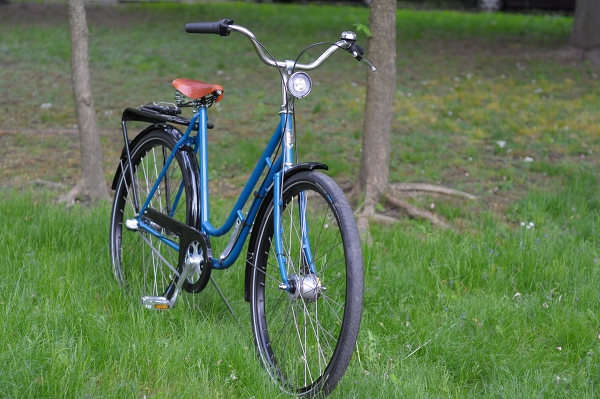 Last week I received a new bicycle for an extended test ride and review: a Pilen Lyx. The distributor (BoxCycles) gave me a choice of colours and I took a gamble once again instead of just asking for black. This time the gamble paid off: The unusual shade of blue looks as stunning in person as it did in pictures. It is an ethereal "northern skies after an afternoon storm" sort of blue that I just want to keep staring at.
Last week I received a new bicycle for an extended test ride and review: a Pilen Lyx. The distributor (BoxCycles) gave me a choice of colours and I took a gamble once again instead of just asking for black. This time the gamble paid off: The unusual shade of blue looks as stunning in person as it did in pictures. It is an ethereal "northern skies after an afternoon storm" sort of blue that I just want to keep staring at. A small Swedish manufacturer, Pilenhas been producing bicycles since 1998. The worksmanship looks outstanding.
A small Swedish manufacturer, Pilenhas been producing bicycles since 1998. The worksmanship looks outstanding. The finishing on the TIG-welded frame with lugged fork crown, seat collar, and capped seat stays is up there with the quality of high-end custom frames.
The finishing on the TIG-welded frame with lugged fork crown, seat collar, and capped seat stays is up there with the quality of high-end custom frames.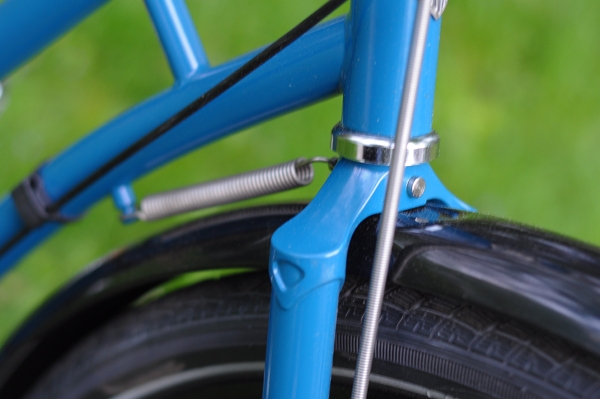 Iwill cover the frame details in the review after I've had more time with the bike, but so far I am pleasantly surprised.
Iwill cover the frame details in the review after I've had more time with the bike, but so far I am pleasantly surprised. Nice headbadge, too. Pilenmeans "arrow" in Swedish.
Nice headbadge, too. Pilenmeans "arrow" in Swedish.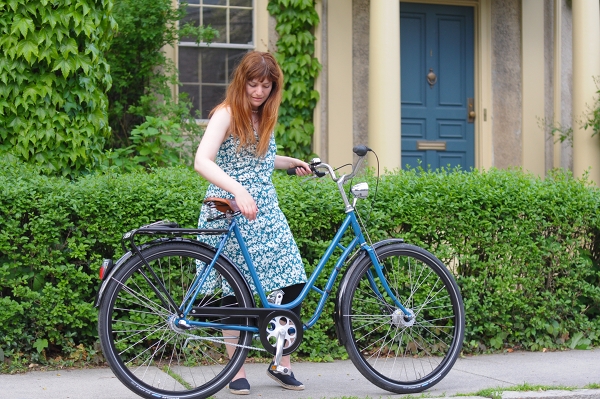 The lady's frame is available in one size only and it is huge: 56cm or 58cm (22"+), depending on how you measure it. At 5'7" I had to slam the saddle down, but I'm used to that: my GazelleandRaleigh DL-1 arethe same size.
The lady's frame is available in one size only and it is huge: 56cm or 58cm (22"+), depending on how you measure it. At 5'7" I had to slam the saddle down, but I'm used to that: my GazelleandRaleigh DL-1 arethe same size.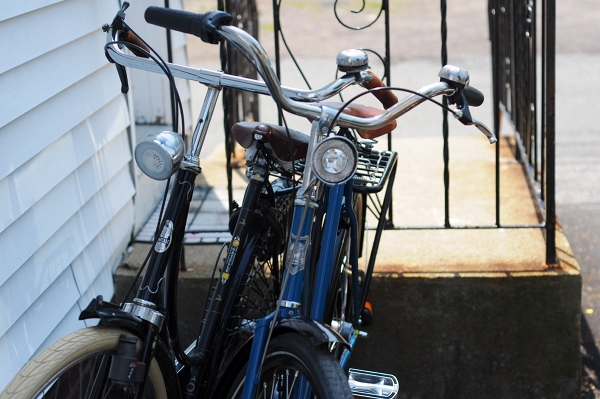 Here are the Gazelleand the Pilentogether. The Pilenwill be kept outdoors for the duration of its visit, which will allow me to test its resistance to the elements. The distributor assumed this as a matter of course, since that is how he keeps his own bike and that is howPilenswere designed to be stored.
Here are the Gazelleand the Pilentogether. The Pilenwill be kept outdoors for the duration of its visit, which will allow me to test its resistance to the elements. The distributor assumed this as a matter of course, since that is how he keeps his own bike and that is howPilenswere designed to be stored. I've been riding the bike since Friday, but am not ready to describe the ride quality yet. It is not like a Dutch bike, and neither is it like an English roadster, so I am trying to "understand" it. I am also still messing with the handlebar and saddle positions and will hold off on my impressions until I get those just right.
I've been riding the bike since Friday, but am not ready to describe the ride quality yet. It is not like a Dutch bike, and neither is it like an English roadster, so I am trying to "understand" it. I am also still messing with the handlebar and saddle positions and will hold off on my impressions until I get those just right. 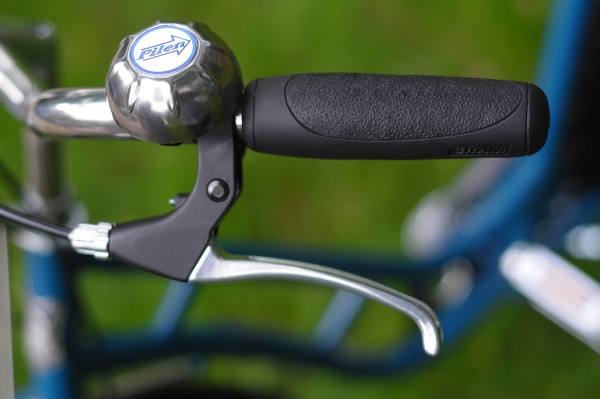 In their generosity, the distributor has given me the green light to give this bicycle away once I am finished reviewing it. There are no strings attached: I can just give it to one of my readers in any way I see fit. This is exciting, and I already have an idea for a contest that is kind of kooky, but hopefully fun. So if you are a taller lady, the Pilencould be yours!The final review will probably be ready in 3 weeks' time, and that is also when the bicycle will be given away.Stay tuned and I will post more about the contest next week!
In their generosity, the distributor has given me the green light to give this bicycle away once I am finished reviewing it. There are no strings attached: I can just give it to one of my readers in any way I see fit. This is exciting, and I already have an idea for a contest that is kind of kooky, but hopefully fun. So if you are a taller lady, the Pilencould be yours!The final review will probably be ready in 3 weeks' time, and that is also when the bicycle will be given away.Stay tuned and I will post more about the contest next week!
 With this.
With this. A .. Dodge Grand Caravan with 31,000 miles on it. I wasn't overly thrilled with the color (or lack thereof), but I can live with it ;-)
A .. Dodge Grand Caravan with 31,000 miles on it. I wasn't overly thrilled with the color (or lack thereof), but I can live with it ;-) Now, why would ol' penny pincher me exchange a little fuel efficient Cavalier, which got 30 miles to the gallon, with a vehicle that will get 8-10 miles per gallon less? Oh! There's a reason. But I'm not telling just yet. For now I'll just say that an extended road trip is in the works. . . it's something that I have been wanting to do for a very long time, and that time has finally come! And the first step has been taken...
Now, why would ol' penny pincher me exchange a little fuel efficient Cavalier, which got 30 miles to the gallon, with a vehicle that will get 8-10 miles per gallon less? Oh! There's a reason. But I'm not telling just yet. For now I'll just say that an extended road trip is in the works. . . it's something that I have been wanting to do for a very long time, and that time has finally come! And the first step has been taken...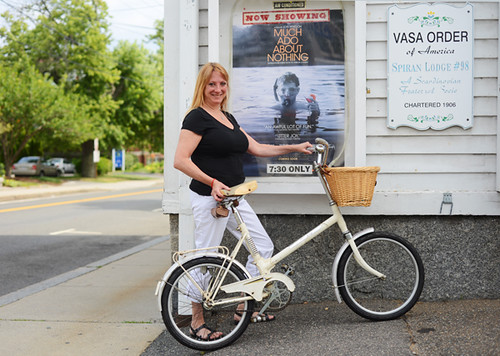





 The caption under this picture in the display reads: “Men of the 9th Indiana, a regiment of Hazen's brigade in the Army of the Ohio, in camp before the battle.”
The caption under this picture in the display reads: “Men of the 9th Indiana, a regiment of Hazen's brigade in the Army of the Ohio, in camp before the battle.” 






